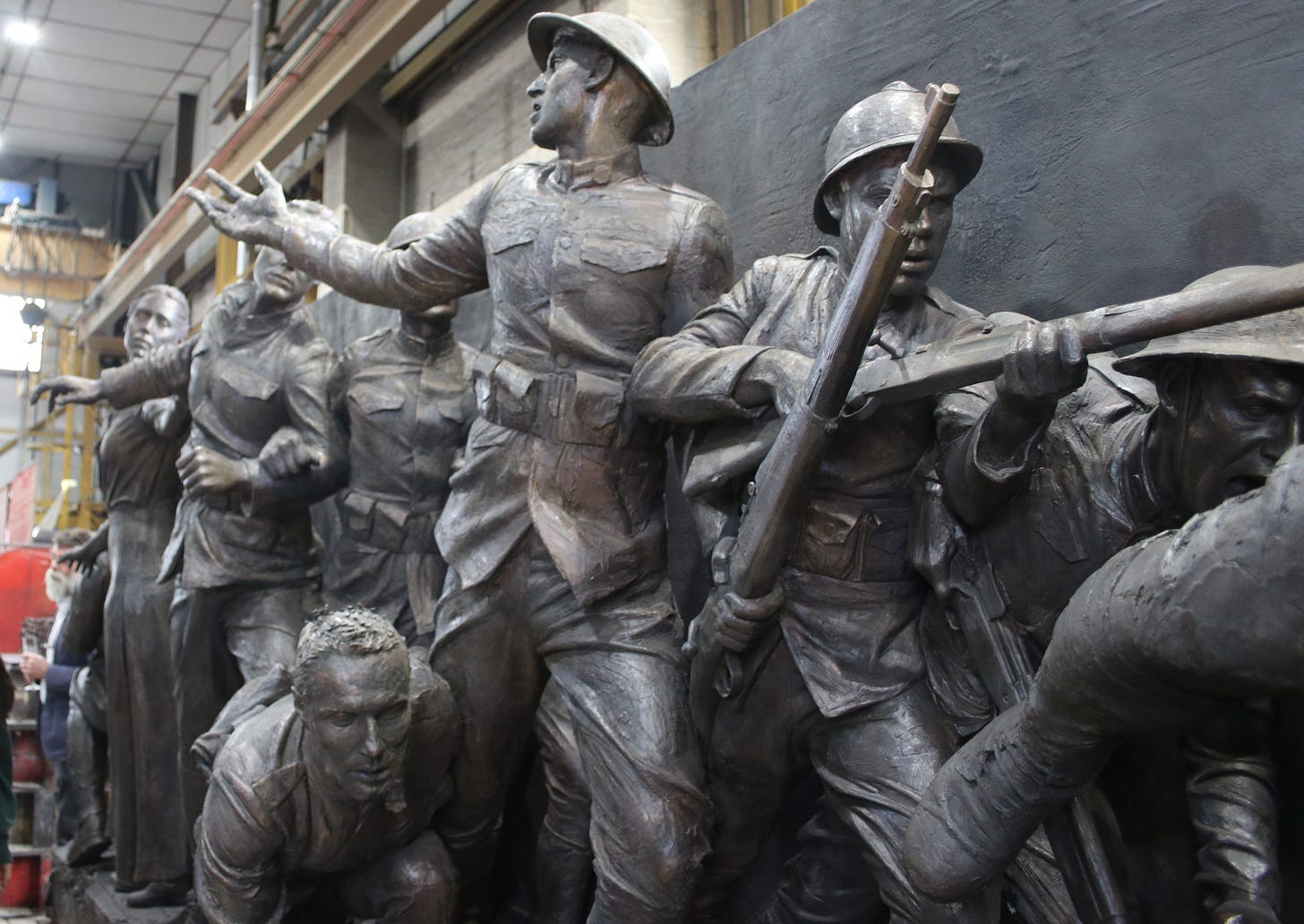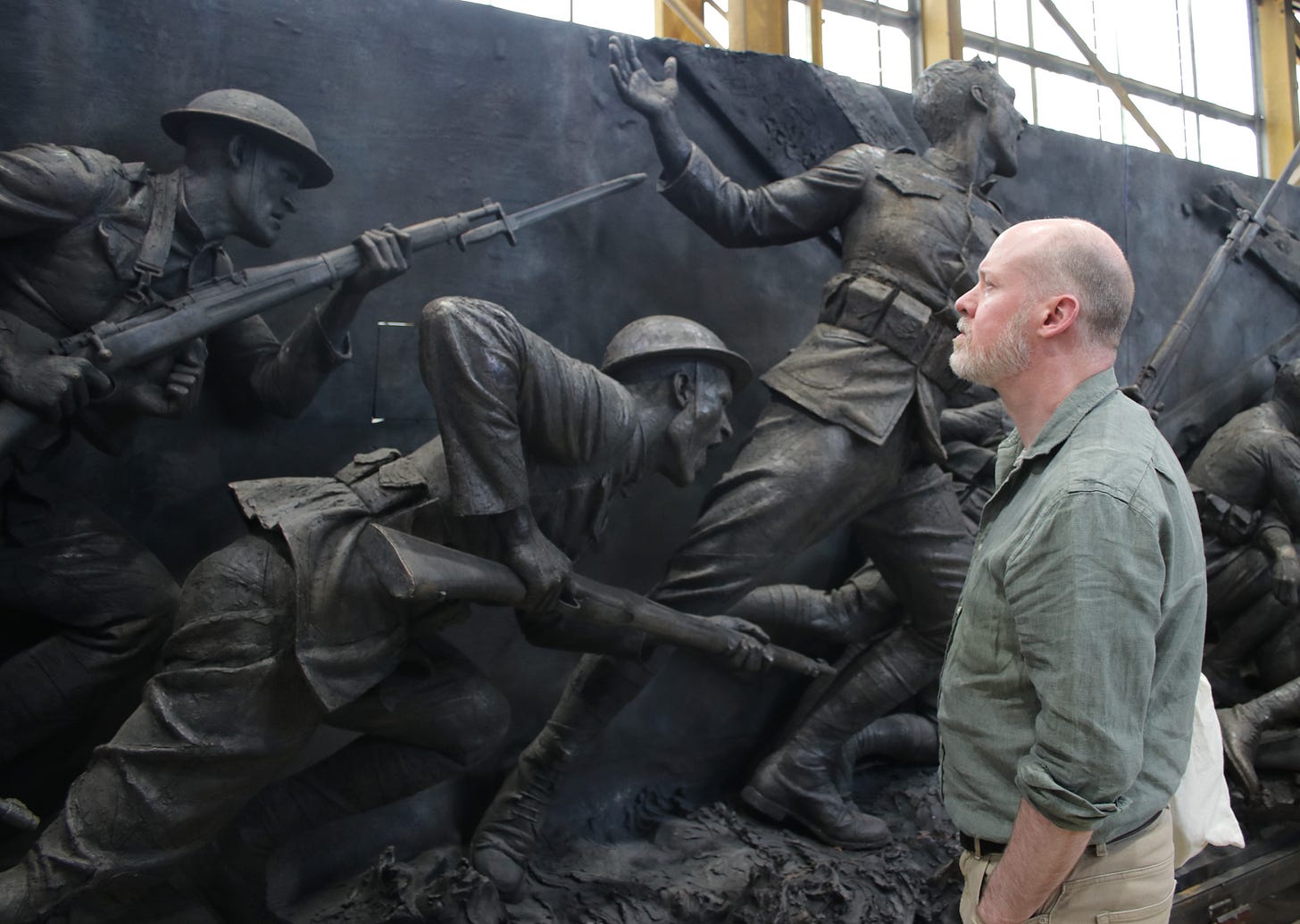The preservation of fire
On the eve of Veteran's Day, Sabin Howard, sculptor of a new memorial in Washington DC, talks to me of rebellion and the preservation of a sacred fire.
I.
On a sunny June day, a trickle of taxis and limos brought people to an industrial site in a wooded valley outside Stroud, West England. Filling the centre of a foundry was the newly finished future National World War I Memorial, a giant bronze frieze depicting an American soldier’s journey through World War I. Standing 10 foot tall and 58 foot wide (presented on a low base), the sculpture dominates through its imposing physical and affecting emotional presence. The memorial is due to be situated near the White House, Washington DC, unveiled on the 13th of September.
Sabin Howard’s memorial sculpture A Soldier’s Journey (2024) is narrative, sequenced in scenes from left to right, composed of 38 over-life-size figures. It commences with a man receiving a helmet from his daughter, as if entrusted with a sacred chivalric task. His wife reluctantly allows him to join battle, her hand lingering on his arm; his other arm is linked through that of a comrade. The soldiers pelt into combat, suffer losses and (with a nurse) support the wounded and comfort the dying, before the man stands shellshocked. The American servicemen (of varying services, ranks and races) march to a sombre victory. At the end, the soldier, finally home, humbly returns the helmet to his daughter. The entire sculpture (between its discrete still commencement and conclusion) is animated by a flowing rhythm, dynamic in its range of animation.
It is full of telling details – lost buttons, taught muscles, fitting facial expressions – but is sculpted in a way that is never naturalistic or fussy and which never denies its source physical nature as manipulated clay. The slightly rough finish catches the light and holds the eye. Howard’s previous works, which have included life-size Greek gods, had a flawless finish; in this memorial, Howard adopted a fittingly raw finish. That finish is never showy or bravura but lively. If a smooth verisimilitude had been attempted, it would have given a rather deadening feel and slick appearance. Similarly smooth as they may be, the metal barrel of a carbine, the surface of an eye, stretched skin and still water should never be indistinguishable in statuary; they demand conscious definition.
At the opening, the artist spoke of his desire for the sculpture to reach and move a mass audience, one that does not usually enter an art gallery. For Howard, it is clear the substance and appreciation of art is not a matter to be neither gatekept nor endorsed by authority. One might consider a dichotomy here, for the winner of a major competition to be rejecting the importance of official endorsement. Howard’s speech is passionate and earnest, without arrogance or egotism. He sees himself as the servant of his art.
The significance of this major memorial (commissioned only a few years after the 2020 riots and targeted iconoclasm) was not lost upon attendees, some of whom had publicly campaigned for preservation of public statuary. Not least, Howard himself had declared himself in favour of retaining existing monuments. Now his own contribution is ready to find its home in the national capital, surrounded by august and iconic monuments.
II.
When I interviewed the artist in early August, it was during a break from assembling A Soldier’s Journey in Pershing Park, at the heart of Washington DC. As a barrage of notifications (some urgent) sounded his mobile phone, Howard moved fluidly between the demands of work, interview and domestic life. What he tells me suggests he was not a Beltway insider’s idea of a “reliable” artist. Born in 1963 and having grown up during the Vietnam War, Howard describes himself as “very anti-government and anti-war” and “suspicious of large bureaucracies”. Howard has a temperamental independence from the subject of the USA as a military power operating overseas and a political distance from the authorities overseeing this memorial.
Howard is an outsider, who (for 35 years) has stood apart from the main streams of commercial art. He eschews Modernism and Post-Modernism. Modernism’s agenda of unending progress necessitates rejection – even destruction – which goes against the grain for Howard. His outspoken character leaves him isolated, not least because he refuses to join any artistic or political movement. “I’m a hooligan,” admits Howard, laughing, “but a hooligan fighting for truth and light.”
Howard (who has strong links to Italy) has spoken of the inspiration he derives from Renaissance sculpture. This came to the fore in his own sculptures of classical heroes. Yet he is wary of adopting idioms in order to accrue authority or falling into historicism. “I am deeply averse to artists who are archaeological,” he told me. “I don’t want to resuscitate the past. There is a Gustav Mahler quote which is “Tradition is not the worship of ashes but the preservation of fire.” What I am doing is preserving that which is sacred, that which is human, but I am recreating to contemporary standards because I live in these times.”
Howard’s sensitivity to the demands of statues as sculptural form, aside from considerations of naturalism, comes through in A Soldier’s Journey. Upon close observation, the great care taken over the observation of models and the care in making each figure individual in character and presence is obvious. Looking at the figures closely, one is made vividly aware of the unique experience and response of every person in the war. The emotional power that seems a key requisite for a memorial is one that is harnessed and articulated clearly and effectively by the narrative Howard invented. In deciding to weave the incidents into a flowing narrative (rather than relying on discrete episodes), the artist gives the memorial a coherence and a compelling power. By generating a figurative propulsive energy through movement and story, Howard chose the more difficult and rewarding path for his memorial.
The artist spent a long time examining clothing and weaponry of the US infantry of the period. He also took care in selecting appropriate models for servicemen and women depicted. The artist worked from life directly with models. Howard rejects the common reliance on photography and computer imagery, noting them as purely mechanical systems. When we talk of scanning and 3D printing, Howard notes, “It takes away the human fingerprint. It replaces it with a mechanical fingerprint. You need the translation, not a mimicking. There’s an intelligence in translation into form.”
Howard’s commitment to his vision means he can be an exacting taskmaster. “I fired six or seven people,” he tells me, when discussing an early stage, working in New Zealand. He had never worked on a project as large as this, so he acquired new understanding as the sculpture developed. It became easier for him to do some tasks than to explain his intentions to others. It meant that by the end of the process the artist was working with one assistant on the models. He was expansive in his praise for the technicians at Pangolin Foundry. He was also generous in his admiration for Charles Jagger’s Royal Artillery Memorial (1925), at Hyde Park Corner, which he studied at length when he arrived in England to work on his own memorial.
When I ask the sculptor about what his response might be to a monument commemorating the Iraq or Afghanistan wars, he is doubtful. He describes them as political wars and finds them too recent to be able to view them at a distance. Troubled by these more recent American conflicts, Howard concedes, “I would do a memorial for the veterans, rather than the war itself.”
A Soldier’s Journey is a remarkable achievement. It has the grandeur and dignity befitting a national memorial. It also has the empathy and engagement that one finds in fine art of the highest order. This accomplishment is a fine memorial to the dead of the Great War – one which puts recent monuments in Britain to shame – and a significant work of sculpture.




I certainly will!
Thank you for this beautifully written examination of this incredible art. What a joy to read and behold and what a fitting tribute to the WWI veterans. It carries the weight of those sacrifices; I can’t imagine how moving it is in person.